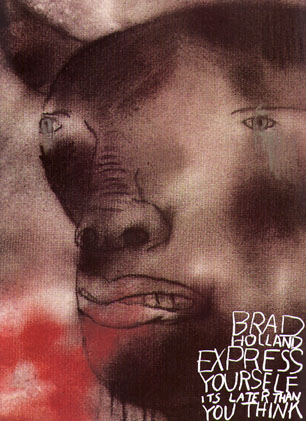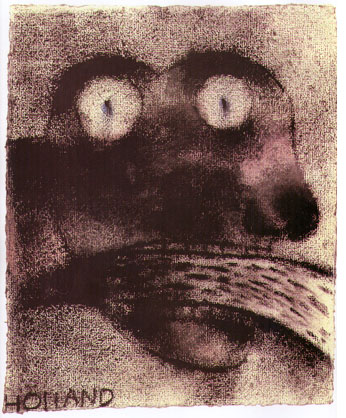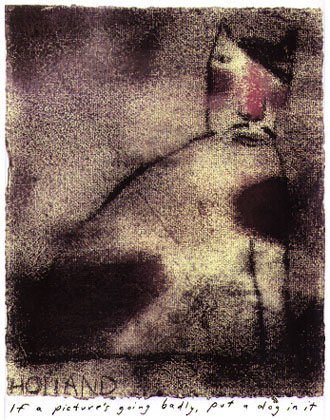NY Art Commentary --
Express Yourself -- It's Later Than You Think
by Brad Holland

Brad Holland © All Rights Reserved
NY Art Commentary --Express Yourself -- It's Later Than You Thinkby Brad Holland |
 Brad Holland © All Rights Reserved |
|
|
A quarter century ago, Ad Reinhardt announced that his black paintings had made him history's ultimate artist. He said he had taken art as far as it could go. He had solved all its problems. There was nothing left to do. The critics were impressed. But unfortunately, a lot of other artists refused to hand in their brushes, so art continued. |
|
|
Ever since, Modern Art has resembled a doomsday cult on the day after the deadline for the end of the world. The true believers have awakened to find that the sun has risen, the mad prophet's disappeared and they've all got to find something to do with the rest of their lives. They dissolve into factions with rival theories about what happened, what it means and what they've going to do next. In art, this predicament is what they call Postmodernism. And if you're confused about it, it's probably because you're beginning to understand it. If you're an artist, the next few pages will be old hat to you. But as a public service for the layman, I've been asked to define a few of the basic terms. Modern Art: It's best to get this out of the way first. In the future, Modern Art won't mean what it does now. It will mean "the kind of art they did in the twentieth century". Like saying "Baroque" or "Romanesque," to call something "Modern" will be a way of dating it. |
 Brad Holland © 1996 |
Contemporary Art: A handful of people who grew up before TV still think that all artists either paint like Picasso or like Norman Rockwell. That was true 80 years ago, but these days all artists want to be popular . If they were starting their careers today, Rockwell and Picasso would probably both be painting on black velvet. Art History: In the Stone Age, artists expressed themselves with crude pictures on the walls of their caves. Then there was a period of transition that lasted roughly 10,000 years. Then came Modern Art. Now we can express ourselves again. If you want to know the details, you can go to art school and spend thousands of dollars, but this is basically what they'll teach you. I've boiled it down. |
|
Cubism: This was a movement started by Picasso and Braque to distinguish their work from what Cezanne had already done, but failed to give a name to. In Modern Art, naming your art movement is a must. Cubism is still the most important art movement for the same reason that John D. is still the most important Rockefeller. All the other art movements are like downtown Rockefellers, and you can forget about them unless you expect to encounter an art category on "Jeopardy". Futurism: This was a movement of intellecutuals who wanted to replace tradition with the modern world of machinery, speed, violence, and public relations. It proves that we should be careful what intellectuals wish for, because we might get it. Surrealism: An archaic term. Formerly an art movement. No longer distinguishable from everyday life. |
 Brad Holland © 1996 |
Dada: Dada artists were ironists. Duchamp was their star and his masterpiece was a urinal. He ended his life playing chess. He claimed he was making an art statement. My grandfather had a sense of humor too. And he ended his life playing chess. But since he did it to keep from being bored, no one thought it proved anything. This suggests that Dada artists are exempt from the general rule that ironists are the biggest victims of their own irony. Abstract Expressionism: After World War II, the United States emerged as the world's superpower. American companies like Cities Service and Esso, which had once been regional businesses, became international corporations. They adopted abstract names like "Citgo"; and "Exxon" to give themselves world-class status. Since multinational giants couldn't have little pictures of red barns or weeping clowns in the lobbies of their Bauhaus buildings, Abstract Expressionism emerged as the world's most overrated form of interior decoration. |
Minimalism: During the era of Bugaloo and the Frug, Abstract Expressionism expanded into a large ball of hot gas, then suddenly collapsed into a black hole, where it still sits, spinning and refusing to give off light. This event was called Minimalism. A lot of people believed it was the final stage in the evolution of art. But it turned out to be just another bump in the gravitational field of Western culture. |
|
Pop Art: In aristocratic societies, rich people used to commission exquisite paintings for their walls. Years later, cheap imitations would filter down to calendars in gas stations. In our democratic society, this works backwards. Here, art begins as the kind of picture you'd find on a matchbook cover. Then expensive imitations of it wind up on the walls of plastic surgeons and Hollywood agents. Op Art: I can never keep my mind on Op Art. It always reminds me of The Continental Op, Dashiell Hammett's detective. That makes me think of The Maltese Falcon, which makes me think of Humphrey Bogart, which reminds me of Play it Again, Sam . That reminds me of Woody Allen, and the next thing I know, I'm thinking about Diane Keaton. I don't know if anyone else has a similar experience with Op Art. |
|
New Art: New Art follows Old Art. Comes before New Improved Art. New Wave Art: Modern Art as it would have been done by The Big Bopper, The Del Vikings, or Sam the Sham and the Pharoahs. New Wave Art is exhibited in Oldies-but-Goodies Museums now, usually in black and pink frames. Graffiti Art: Many people decorate their homes with designer graffiti, even though most of them would probably have real graffiti scoured off the outsides of their buildings. Personally, I think that graffiti artists should go to the homes of their patrons with spray cans and make their condos look like subway cars. This would separate serious lovers of graffiti from uptowners spelunking for art thrills. Realism: Currently, realistic paintings are valued for their craftmanship. In the next century, when art will be packaged as virtual reality software, realistic paintings will sell the way Shaker furniture does now. Shaker futrniture will sell the way Van Gogh paintings do. And teddy bears owned by Elvis will come to auction only occasionally. Commercial Art: Anything done by an artist with a cash register by the door. Commercial Art is traditionally delivered to a client in a brown paper bag with an invoice stapled to the outside. Fine Art versus Commercial Art: In commercial art, you find out how much they're going to pay you, then you do the work. In fine art, it's the other way around. |
|
Brad Holland © 1996
 If a picture is going badly, put a dog in it. |
"That's Not Art, That's Illustration": Almost everybody is an artist these days. Rock and Roll singers are artists. So are movie directors, performance artists, make-up artists, tattoo artists, con artists and rap artists. Movie stars are artists. Madonna is an artist, because she explores her own sexuality. Snoop Doggy Dogg is an artist because he explores other people's sexuality. Victims who express their pain are artists. So are guys in prison who express themselves on shirt cardboard. Even consumers are artists when they express themselves in their selection of commodities. The only people left in America who seem not to be artists are illustrators. Love me, Love my Art: Norman Rockwell used to say if a picture was going badly, put a dog in it. If it was going really badly, put a bandage on the dog's paw. This is the basic principle behind Victim Art. Tattoo art: Personally I've never liked tattoos, although I think they improve some people. Especially the kind of people who hang around tattoo parlors. |
| Kitsch: In my lifetime, Kitsch has progressed from the cynical sentimentality of Maxfield Parrish calendars to the sentimental cynicism of Batman movies. |
| Popular Art: In America, the only truly popular art form is the movies. Most people consider painting a hobby and literature, schoolwork. Star, Superstar, Black Hole: A modern Renaissance Man is unlikely to become a celebrity. But any celebrity can be a Renaissance Man. The great number of entertainers turned painters testifies to this. Look at Tony Curtis, Tony Bennet, Anthony Quinn, Billy Dee Williams, Red Skelton, Prince, Ron Wood and Frank Sinatra. they all have galleries for their paintings, and as far as I know, there are books about their work. I read an interview with Sylvester Stallone, in which he talked about his graffiti paintings. He said that drawing and color aren't important, as long as you get your feelings "out there". I confess that after years of struggling with drawing and color, that was a load off my mind. |
 Brad Holland © 1996 Tatoos Improve Some People. |
|
Style: Style is the most valuable asset of the modern artist. That's probably why so many styles are reported lost or stolen each year. Art School: One of the frequent casualties of higher education is common sense. Art education is a good example of this. In high school, most kids draw little more than unicorns and super heroes. Then suddenly, in four years of art school, they're supposed to develop an original style. That's something even Rembrandt couldn't have done. So a lot of students wisely spend their four years cultivating gimmicks they can call a style, and mastering Artspeak. This means that, as professionals, they can say things like, "I do purloined images on Naugahyde." Or, "These mutilated Barbie Dolls represent feminist praxis in action." Tradition: There are still some traditionalists, mostly employed by art schools, who continue to paint like the Ashcan School. For years, it's pleased the avant-garde to keep those Amish around to portray the Art Establishment. But for generations, the real Art Establishment has been made up of earth sculptors, body piercers and topless cello players. It's been a long time since a painter of the Ashcan School has even had a prayer. The Avant-Garde: |
Brad Holland © All Rights Reserved
NYAW.COM 2015

|